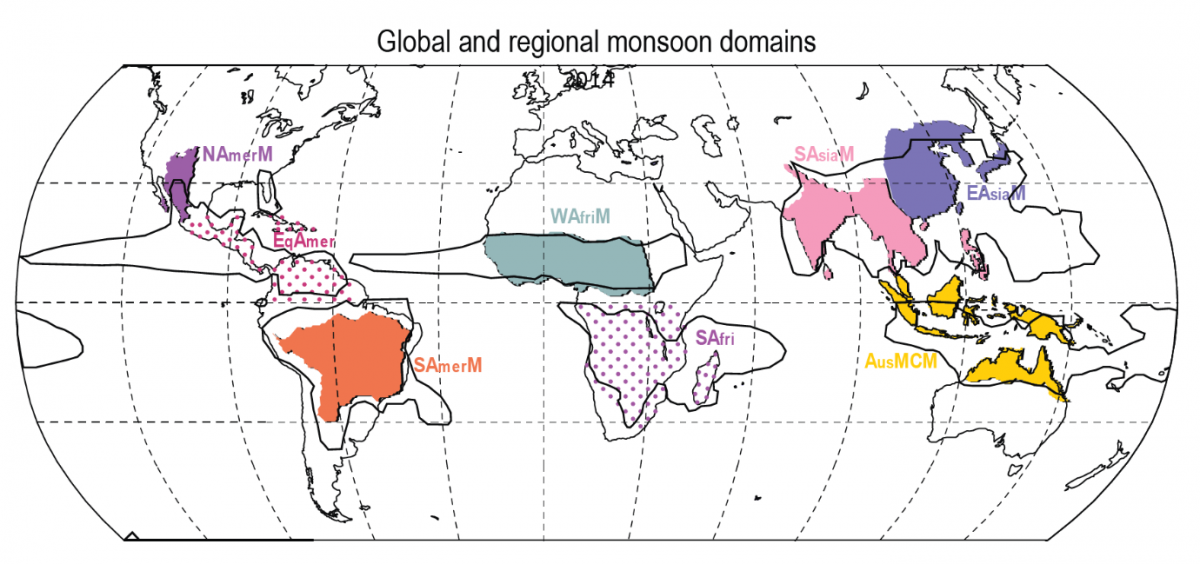About Monsoons

Global (black contour) and regional monsoons (color shaded) domains. The global monsoon (GM) is defined as the area with local summer-minus-winter precipitation rate exceeding 2.5 mm/day. The regional monsoon domains are defined based on published literature and expert judgement and also accounting for the fact that the climatological summer monsoon rainy season varies across the individual regions (Source: IPCC, 2021).
INTRODUCTION
Monsoons are identified as seasonal transitions of atmospheric circulation and precipitation regimes in response to the annual cycle of solar insolation and the distribution of moist static energy. Tropospheric temperature gradients, developing during springtime, and differential heating of underlying land and ocean are precursors and triggers in most of the monsoon regions. Monsoons are grouped into Asia-Australia, African and American according to their location and summer versus winter precipitation regimes seasonality.
Progress in our scientific understanding of monsoons will benefit from the interaction of individuals and groups studying these various regions. CLIVAR (Climate and Ocean: Variability, Predictability and Change) research into ocean-atmosphere interaction and the role of slowly varying modes that lend predictability to the monsoons is of direct relevance to the Monsoons Panel; furthermore, GEWEX (Global Water and Energy Exchanges) activities in land-atmosphere interaction and convective scale processes are key to understanding monsoons from regional to global scales. As a result, a joint Monsoons Panel spanning CLIVAR and GEWEX is convened of membership drawn from both communities; the panel reports to both CLIVAR and GEWEX Scientific Steering Groups.
STRUCTURE
The Monsoons Panel has established a structure of three Regional Monsoon Working Groups, focusing on the Asian-Australian, American and African monsoon regions. The Monsoons Panel explores a more global view of monsoon activities, enabling knowledge and best practices to be shared between the various monsoon regions. It attempts to better coordinate monsoons research between GEWEX and CLIVAR, particularly in emphasizing the role of convection and land surface in the monsoons, in addition to ocean-atmosphere interaction.
Working groups under the Panel are leading regionally focused monsoon research in each of the three areas of globe. The Panel has been defining concrete activities to be fostered in the coming years, coordinating the regional working groups, and acting as a hub to facilitate meetings and linkages among international research efforts. Advancing understanding of monsoon variability and improving prediction remain the principal goals promoted by the Monsoons Panel, but greater emphasis is being placed on linkages across scales and to phenomena that have historically been outside the purview of classical monsoon research. Observation and modelling are still the cornerstones of the research efforts. The Panel seeks to bring new methods and fresh perspectives to the problem that can enhance monitoring, advance diagnostic efforts, and improve component and coupled models. Thus, key to these efforts will be the development of new and better process studies (particularly, emphasizing the role of convection and land-surface processes in models), coordinating with relevant modelling efforts including those related to climate change, strengthening the links between research and operational forecasting stakeholders and empowering the next generation of young scientists from around the world to advance our knowledge of monsoon systems. Scientific works include observational field campaign and process modelling work, coordination of and contribution to climate change efforts in CMIP, and utilising our understanding of subseasonal-to-seasonal variability to aid enhancement of monsoon prediction on these scales.
The Monsoons Panel is supported by the International Monsoons Project Office (IMPO), hosted by the Indian Institute of Tropical Meteorology (IITM) located in Pune, India.
Near-term and Long-term Plans:
The Monsoons Panel will actively pursue better integration of CLIVAR and GEWEX monsoons activities, such as CLIVAR Oceanic regional panels, GEWEX Global Land/Atmosphere System Study (GLASS), Global Atmospheric System Study (GASS) and Hydroclimatology panels (land-atmosphere interaction and convection, in particular).
The Monsoons Panel will foster better utilization of model outputs such as those from the Global Monsoons MIP and CMIP6 DECK experiments, including through coordinated analysis at the regional and global monsoon scales.
The regional working groups will promote and facilitate active engagement and interaction among research and operational prediction stakeholders in the different monsoon regions, and provide authoritative information on processes understanding, models' fidelity in their monsoon representations, and forecast skill assessment. Members will participate in the many different Regional Climate Outlook Forums (RCOFs) to provide guidance on model strengths and weaknesses.
The Monsoons Panel will continue to identify cross-regional commonalities in their activities. One of the key identified activities of interest across the regions is better understanding of subseasonal-to-seasonal variability and exploiting it for better prediction. Regional priorities will continue to be identified by the regional working groups.













